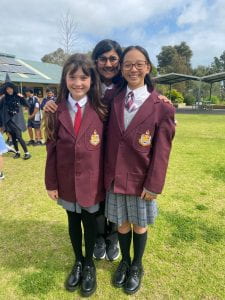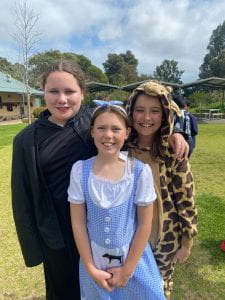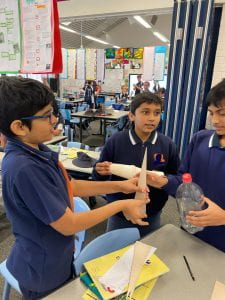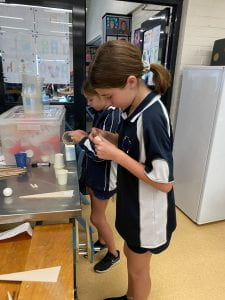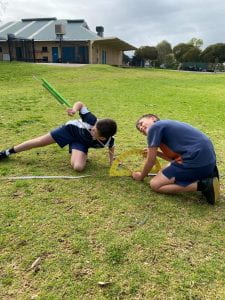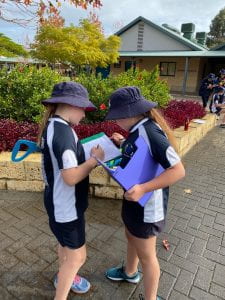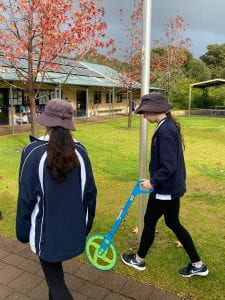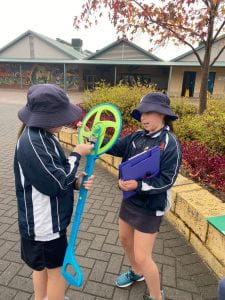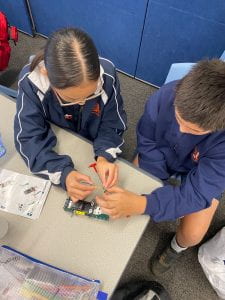One of the favourite parts of the classroom for the younger kids is the dress-up box. They love feeding their imaginations by diving into the box, dressing up and taking on the roles of different characters. Dressing up as a character is what the big kids also did last week as we had our book week. It was great to see the enthusiasm the students had for this day and the imagination they used to in creating their characters. It wasn’t all down to ready made outfits, some of the students improvised with whatever they had in their wardrobes and they did a fabulous job. However, book week wasn’t the only chance the students had to feed their love of dress-up, the previous week saw three of our mini Einsteins host the science assembly, and do you reckon they could resist the chance to dress up? Check out our impressive three mad scientists and our book week characters below.
Take A Break
This year is flying by so quickly, to think we’re over half way through the third term already is almost alarming. The passing of time is relentless, but so is the learning. This term has seen our focus change to our novel study of the excellent Fish in a Tree by Lynda Mullaly Hunt. It’s a novel filled with symbolism, imagery and characterisation, and our studies have taken us deep into a complex analysis which will enrich the comprehension skills of the students. However, it’s not all about sitting at our desks and being serious (although we do need a healthy amount of that), but term three has also included a great deal of hands-on fun. We’ve got down on the carpet to check our knowledge of capacity; we’ve worked in friendship groups to construct rockets for science week; we’ve had our faction carnival following a lot of training and sports lessons; and this week we have book week and will attend a talk from a visiting author. We haven’t taken a break from our learning to fit in all these activities, rather, they are a vital part of our teaching and learning – we’ve simply taken a break from our desks.
Stick With It
How can you measure the height of a flagpole when, even stood on a ladder, you’re barely two metres tall? Well, the answer is Maths! Only a few days ago, some of the students couldn’t make heads nor tails of using a protractor. Now, they’re charging off and using angle measurements, lengths, conversions and a very specialised measuring device to gauge the height of various items around the school. Having stuck some sights (rolled up card) to our straight trigonometric inclinometer consideration kit (S.T.I.C.K) the students were ready to begin measuring the heights of the block, flagpole, goal post, trees… The practical uses of maths is always something I strive to include in class so the students can see how it applies to the real world, and have fun at the same time. This time the students practically rose to the challenge and aimed high so they could stick to their task and reach new heights – (ahem, I’m here all week).
Blogging Task #3
This blogging task is all for a good cause. If you’re anything like me there’ll be a number of issues in the world that cause you to get a little frustrated. Amongst the many that concern me are: climate change, deforestation, animal extinction, equal rights, plastic pollution, gender equality, whale hunting, renewable energy, puppy farms, child labour, poverty, slave labour, girls’ rights, freedom of speech… I could actually go on and on and on! These are, in my opinion, just a few of the most important issues of our time and are well worth fighting for. It’s a great thing to get behind a good cause, it gives people a sense of purpose and meaning in life, not to mention the satisfaction of knowing they’re trying to achieve some good in the world.
Do you have a cause that you’d like to be part of? Is there something happening in the world that makes you frustrated? Is there something you’d like saved? Is there something you’d like stopped? Use your blog to shout out for a good cause or a big issue.
Bad Habits
Us humans are funny animals. We so often think we alone are the ones doing something the right way, we pat ourselves on the back for our superiority and shake our heads at all those poor, unenlightened folk we see around us. However, to really be the best version of ourselves we have to do something which, for many, doesn’t come easily – admit we’re wrong! LA14 are taking part in a technology programme which will help them to understand their own technology habits and develop new, healthier ones. In preparing this programme for delivery, I completed the parent course which helps the adults to go through the same process, and I’ll admit I was surprised and a little guilty with what I found out about myself. It takes a decent amount of openness to accept our own faults. As a result of what I discovered, whenever my family and I go for a meal out we make it a no-phone-zone event. Sure, we take our devices (after all, you never know when an emergency may occur), but we do NOT get them out, we don’t “check in” (after all, we’re already with the people who matter most) and we certainly don’t take “selfies”. We just communicate. Obviously, when we get home we can post about where we’ve been for the night and say what a great time we had, but this is after the meal. Trust me, this makes for a much nicer night; it’ll also open your eyes wide to the families around you who are frequently on their phones, often parents while their young children either sit forlornly or run about annoying everyone else. We’ve now taken this practice even further. My wife and I have ditched the couch at mealtimes and now every meal is taken at the table with no devices, not even the tv. Don’t let this get you thinking that we’re odd, it’s a great time to catch up. Sometime families eat in the same room but they’re not together. The presence of devices means they’ve already started the process of separation which only increases throughout the teenage years. Online friends replace family as being more important, even at those most natural moments when the family unit should be reconnecting after a day physically and mentally apart. We take lost family meal times for granted at our peril! Habits aren’t bad things in themselves, but just make sure your habits are good ones not bad ones.
Blogging Task #2
We all need to take care of ourselves! I can’t think of any issue on a personal level more important than our own mental well-being. For too many it’s something that we come to realise mostly when it’s way too late, when our mental health has taken a hit and we are left with the stressful and debilitating consequences. The problem is that we tend to take good mental health for granted, a bit like a well running car; why tinker with it if it’s all fine? However, to keep running smoothly we need to maintain ourselves, especially during the good times, or one day we may just find ourselves in a big mess.
One way of staying mentally healthy is to make sure we give ourselves time for something we enjoy. My stunning little MG F isn’t only my car, it’s my hobby, my interest and a thing that I thoroughly enjoy. I suppose part of it may lie with the fact I used to be a car body repairer, dismantling smashed vehicles and fixing them up like brand new. I’ve still maintained a great interest in cars and I’m always looking to tinker with my MG and improve it (although it does drain my bank account a little). Doing this ensures I make time just for me, to do something I like and that takes my mind off the pressures of everyday life. This new blogging task is to take a photo of your pastime or hobby and post it as a new header with an explanation of what it means to you. How does your hobby make you feel? Does it give you space and time alone? How long have you been doing it? If you don’t have a hobby, how do you find time for yourself to relax?
Homework?
“He knows changes aren’t permanent, but change is.” Some song lyrics can grab us as soon as we hear them, and this line from Rush’s Tom Sawyer did just that. Even as a teenager I got it, but now as an adult it has become even more profound. Now, having been in teaching for 20 years these lyrics have come to represent one of the greatest frustrations of my professional life. The days are the same, still 24 hours long with 6 of them dedicated to helping shape (educationally, and increasingly socially) the young people in our care. This is the same time I had as a child, sat in a classroom in the frozen north (Manchester) watching and listening as my teachers scrawled across their squeaky chalkboards. That was many decades ago. My teachers wouldn’t recognise my job. In the same length of a day we’ve squeezed in all the new technologies (computers didn’t even exist “back in the day”), new subjects (I certainly never learned a second language in primary school), health topics once unthought of (puberty, mental health, safety…), not to mention the ever changing, expanding and evolving English and Math’s subjects. Sadly, we also have to pick up the tab for teaching the types of social behaviours, manners and expectations that society now deems the duty of schools. A friend of mine blamed his teacher for not teaching his child to read the time (I remained quiet), a commentator on the news blamed education for falling short on racial history topics, while another friend of mine moaned the school hadn’t taught her child to catch a ball. Not everything in life has yet, thankfully, been designated a School Only topic, it is, though, perceived that way by some. I’m lucky, I have parents teaching their kids to tell the time, about Jewish history, about the World Wars, the love of family reading time, about multiculturalism and acceptance, about the wonder of science and nature, about conservation and the climate. They’re doing this at home, going into more depth than at all possible in a time ravaged classroom. And although they’re being done at home, it isn’t work – it’s love, nurture and an understanding that the time we all take to invest in our children will pay dividends to the world as a whole. Education has changed and we all have to change with it, as the changes will just keep coming, relentlessly.
Let’s Get Real!
“When are we ever going to use this stuff?” Yeah, if you’re a teacher a question like this will definitely be one you’ve heard before. Well, LA14 have been putting their classroom learning to use and developing skills they can use throughout life. We’ve been learning a lot about area calculations on paper and took an opportunity to get out of the class. Due to a minor earthquake at school (not really) we need to replace some of the paving and grass. The students have to measure the areas, some of them very complex, and calculate the price of the replacements from real commercial websites. The students need to measure accurately, use their calculation knowledge, give reasons for their choice of pavers and grass and explain the process involved. Their work will be presented creatively in a hand-written project (a strange beast in our digital world) and the students seem excited and motivated by the project. Real learning, using real situations in the real world – can’t get any more real than that!
Below are some photos of the students measuring for their project.
Full STEAM Ahead!
As a kid I’d sit for hours letting my imagination run wild as I constructed all kinds of vehicles, bridges, cars and much, much more. Now, as part of our STEAM (integrated Science, Technology, Engineering, Arts and Math’s) activities, we’ve been using Meccano in the classroom, the toy I enjoyed all those years ago. Meccano has strong connections to the topic of robotics and digital technologies, which some students will be choosing to follow in high school; in fact it’s such a fabulous tool with a huge educational value. Besides helping the students develop their problem solving skills and their construction skills, it is also great for their literacy development. The students are having to cooperate in pairs (boy and girl) as they attempt to read, decipher and follow the fairly complex instructions. The instructions are all visual, the type that Ikea tend to use, but a lot more detailed and complex with steps having to be followed in clear stages. As well as requiring good reading skills, the students have to use clear, polite and constructive conversation skills to overcome any difficulties they encounter. The instructions are very similar to an algorithm and must be followed closely. When finished they should have a great model with working parts and can post about their experience on their blogs, as long as they stay on track and don’t come off the rails!
Blogging Task #1
“Go back to where you come from!” Yes, we’ve all heard racist and insulting comments such as this all too often, sometimes even from those in authority and power. The irony here in Australia (and nations such as the USA) is that we’ve ALL come from somewhere else (except for the indigenous peoples). Australia is an immigration nation and this is reflected in my incredible, diverse, multicultural class. I don’t think I’ve ever had such a wonderfully mixed classroom, it adds so much to the richness of our day and is a real example of how we’d all like the world to be – accepting, equal and harmonious. The problem is, though, we sometimes lose those connections to our roots and our heritage and that’s a real shame. I’m from the UK and not long ago I took a DNA test to discover my ancestry. It turns out my ancestors were rather boring. My origins include Scandinavia, Northern Europe, the UK and Ireland, pretty much a reflection of all the nations which came together to form the British people over the last two millennia. Not quite as exotic as I’d hoped for; it seems my ancestors had an aversion to travel! For this Blogging Task I’d like you to talk to your parents (don’t panic) and even your grandparents to find out a little about your origins. Also, why did your family migrate to Australia? Were there “push” factors or “pull” factors which impacted your family and which ended with you sat in a my classroom? Have fun finding out all about yourselves.



